by Todd Rutherford
I wanted to revisit Matt’s post on the 20 Best Xeriscape Plants for Colorado, and add to his list of great low-water plants for Colorado landscapes. As with Matt’s initial posting, this list of plants also offers a great variety of color, texture and form for your water-wise garden. Consider adopting some of these amazing plants into your landscape, and tell all your friends about the benefits and beauty of drought tolerant plants.
Perennials:
- Chocolate Flower – Berlandiera lyrata An intoxicating chocolate scent emanates from the yellow blooms of this low water southwestern wildflower from summer into fall.
- Whirling butterflies – Gaura lindheimeri Whirling Butterflies truly lives up to its name. Growing 2-3’ tall by 18-24” wide, this perennial has a significant bloom time, sporting multiple flower stalks that whirl numerous small white flowers in the late summer breezes.
- Creeping Veronica – Veronica spp. A spring blooming favorite, creeping veronicas are somewhat adaptable to light and moisture conditions. The deep green foliage is often evergreen in winter and makes a nice backdrop to the abundant light blue to purple flowers that arrive in April.
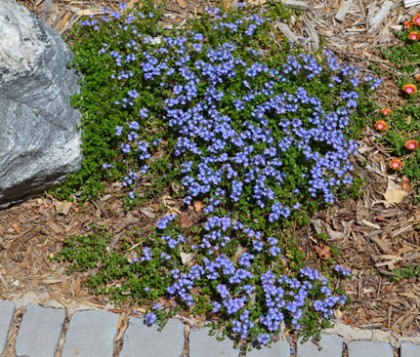
Creeping Veronica
- Sweet Woodruff – Gallium odoratum No dry shade garden should be without this fabulous groundcover. If you have a dry shady spot under a tree, this is the plant for you. It is said that sweet woodruff is one of the few plants that will flourish under the shady canopy of evergreen trees. Small bright green leaves become decorated with tiny white flowers in late spring.
- Orange Carpet Hummingbird Flower – Epilobium canum garrettii If hummingbirds pass through your area consider this California native. It provides a stunning orange floral display in late summer that hummingbirds love, and is ideal to let cascade down a rock wall.
- Blanketflower – Gaillardia aristata Related to sunflowers, this is another North American native that is a great addition to the low-water garden. It blooms from June to September with flower petals that transition from yellow to orange to red. Many cultivars available. Easy to start from seed.
- Silvery Horehound – Marrubium rotundifolium This native of Turkey is a great xeriscape ground cover. It grows 2-4” high and 2-3’ wide. Soft white hairs on the round leaf margins add an effulgent look to the plant.
- Hens and Chicks – Sempervivum spp. This familiar garden succulent from Europe is a hardy performer that will grow just about anywhere. Great for the small spots between other low perennials or rock gardens in full sun. Another nice benefit is how easy it is to transplant the offshoots they provide. Several types are available, with some covered in charming white hairs.
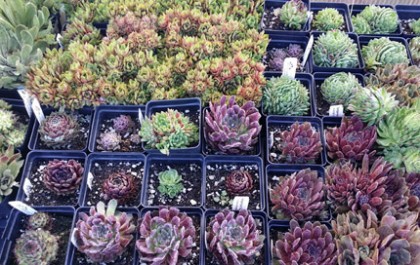
Variety of Sempervivum, a.k.a. Hens and Chicks
- Sunrose – Helianthemum This hardy low-growing perennial provides a delightful floral display starting in June. The profuse blooms hover over a thick mass of low branches that carry small, oval shaped leaves. The flower color is available in shades of red, orange, yellow, pink and white. Perfect for a rock garden or a hot and sunny border area.
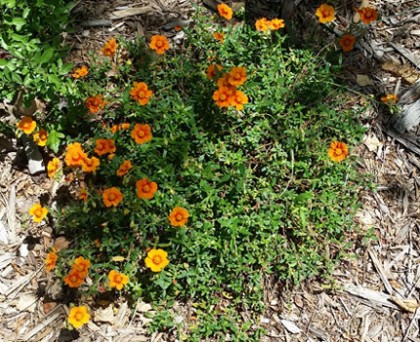
Orange Sunrose
Grasses:
- Blonde Ambition – Bouteloua gracilis ‘Blonde Ambition’ This is a wonderful medium sized grass, 30-36” high and 30-36” wide. It provides multiple seasons of interest, showcasing the classic blue grama grass curled seed heads well into winter.
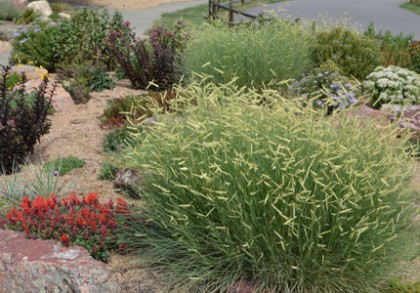
‘Blonde Ambition’ Blue Grama Grass
- ‘Undaunted’ Ruby Muhly – Muhlenbergia reverchonii A 2014 Plant Select introduction. Discovered by Lauren and Scott Ogden, it hails from Oklahoma and Texas. The inflorescence (aka flower cluster) is composed of clouds of tiny pinkish flowers, creating a pink glow with back lighting.
Shrubs:
- Currant – Ribes spp. Currants are medium sized shrubs that grow well in sun, and some species also grow well in filtered shade. This is a notable fact, as many shrubs that do well in part shade require more water than the currants do. Some species provide edible fruit, and some have fragrant flowers. The most notable fragrant currant is Crandall Clove Currant, whose flowers do indeed smell like cloves.
- Dwarf Russian Almond – Prunus tenella Native to Eurasia, this flowering shrub is said to be hardy to zone 2!!! Abundant with pink flowers in the spring, one disadvantage of this shrub is the aggressive suckering habit which may make it hard to control, but this also makes it an attractive cover for wildlife. Size is 3-5’ x 3-5’.
- Dwarf Pinyon Pine – Pinus edulis This slow growing selection of pinyon pine was introduced by Plant Select in 2014. Grows 20-30” height by 20-30” width in 10 years.
- Mohican Viburnum – Viburnum lantana ‘Mohican’ Another great low water shrub that does well in either full or part sun, this viburnum grows 6’ by 6’. White flowers in spring precede orange to red fruits that darken to black in fall.
- Mountain Mahogany – Cercocarpus spp. This western native is indispensable if you’re planning on creating a large native style landscape. Some species are semi-evergreen and one species Cercocarpus montanus the leaves turn a nice russet color in fall. Seeds provide a charming fuzzy appearance that looks great when backlit.
- Peashrub – Caragana spp. A tough shrub from Siberia and China, the peas shrub is, just as the name indicates, related to peas. It produces edible (but not palatable) pods and edible yellow flowers that interest to salads. There are several different species and cultivars to choose from, which range in size from medium to large.
Trees
- Bigtooth Maple – Acer grandidentatum Native to the inter-mountain West, and closely related to the sugar maple. Often growing as multi-stem, it likes full sun to partial shade and low to medium water. The samaras, or winged seeds turn rose color in late summer, and the fall foliage ranges from yellow to red. Grows 20-30’ high by 20-30’ wide.
- Desert Willow – Chilopsis linearis Another typically multi-stem small tree, it is hardy to zone 7 (0 to 5 deg F), but usually survives Denver winters, dying back to the ground each winter, and quickly sprouting new growth each summer. If given a sheltered spot, it may not die back to the ground. Distinctive pink to burgundy flowers with yellow throats. Drought tolerant, with watering being deep and infrequent. Grows 6-30’ high by 6-30’.
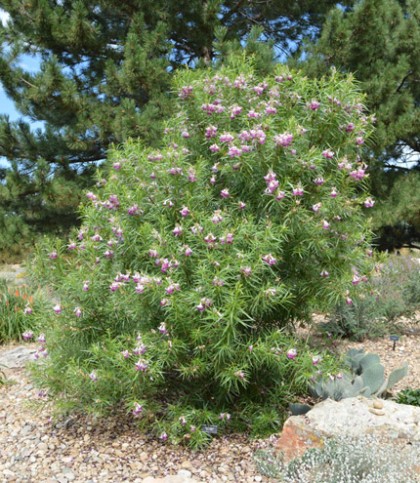
Desert Willow
- Hawthorn – Crataegus spp. These flowering trees are cousins of roses, and bloom in spring with clusters of white flowers that produce long lasting red fruits that offer winter interest. Several species and cultivars have thorns on the branches. Grows 15-25’ high by 15-25’ wide, depending on species and cultivar.
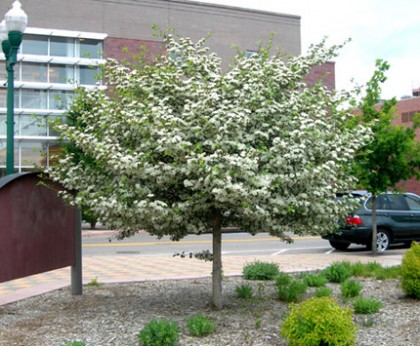
Hawthorn
The Criteria for this List:
– This list is for the Front Range of Colorado. We are somewhere in the middle of zone 4 to 5 on the USDA Plant Hardiness Zone Map.
– I have only included plants that are very easy to care for, and have excluded plants that require a lot of water since that is a key component of Xeriscape. The “best” plants, in my opinion, are those that are well adapted to the local climate and do not require much additional water and maintenance. Of course there are occasions where the use of higher water-use plants is desirable, such as in drainage areas, however I have left them off of this particular list.
This is the official blog of Outdoor Design Group, Colorado Landscape Architects. For more information about our business and our services, click here.
Related Posts:
by Todd Rutherford
You may have heard recent dire reports about the health of bees and butterflies. Whether it’s the declining number of the amazing Monarch Butterfly or the constant reports of “colony collapse disorder” in beehives, these reports are alarming. One of the best and easiest things you can do to help these crucial creatures survive and thrive is to plant the perennials, shrubs and trees in your landscape that will give bees and butterflies the food they depend on. Help these pollinators while creating an inviting outdoor space for yourself. Or, if you are pondering the possibility of updating your landscaping in the near future, let Outdoor Design Group design a bee and butterfly friendly garden for you.
Below are listed several different perennials, shrubs and trees that provide food for bees, butterflies and other pollinators. While I’ve listed several pollinator friendly plants here, there are still many more to choose from. Consult the Xerces Society, a nonprofit organization that protects wildlife through the conservation of invertebrates and their habitat, or your local university extension agent for more suggestions of pollinator friendly plants that will grow well in your area.
Perennials for Butterflies and Bees
Asclepias species. Commonly referred to as the Milkweeds due to their milky sap, there are many species in the Asclepias genus that are utilized by butterflies and bees. Many biologists believe that the decline in the Monarch butterfly population is directly correlated to the increasing use of herbicides used to kill Milkweeds in North America, because Monarch butterflies depend on Milkweeds as food for their larvae. There are many Asclepias species that grow in North America, but two that do well in Colorado are Asclepias tuberosa (showy milkweed) and Asclepias speciosa (butterfly weed). Ht. and Wd. varies depending on species and cultivar, generally 15-60” Ht. x 12-18” Wd.
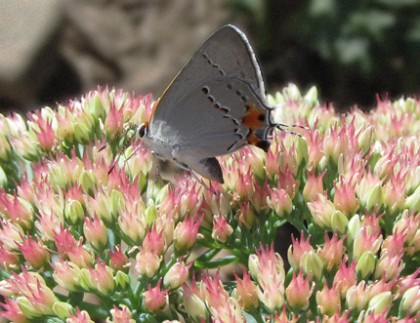
The Mint Family (Lamiaceae). Many familiar and popular garden plants from the so-called Mint Family are favored by bees. Some of these are culinary sage, Russian sage, mint, basil, rosemary, oregano, thyme, lavender, lamb’s ear, hyssop, lemon balm, and bee balm. Ht. and Wd. varies depending on species and cultivar.
Sedum ‘Autumn Joy’. This tall stone crop flowers in mid to late summer (see photo above), making it a good late-season nectar source for pollinators when many other plants have stopped flowering. 18-24” Ht. x 12-18” Wd.
Datura wrightii Although Sacred Datura may not always be a perennial in all parts of Colorado, depending on the severity of the winter, bees love it’s flowers which emit an amazing scent, so even if it is frost tender and may need to be regrown from seed in colder areas, it is worth it. The bees will thank you. 18-24” Ht. x 6-8’ Wd.
Shrubs for Butterflies and Bees
Buddleia alternifolia ‘Argentea’, Silver Fountain Butterfly Bush. This butterfly bush blooms earlier than the other species and cultivars of Buddleia. This large shrub does well in most soils and sites but doesn’t like its roots to stay wet. 12-15’ Ht. x 10-12’ Wd.
Caryopteris x clandonensis ‘Blue Mist’. Blue Mist Spirea is also in the Mint Family, and is not a true spirea, but has flowers that resemble those of the spirea. It is a hybrid of C. incana x C. mongolica that was created in the 1930’s in England by Arthur Simmonds. There are several cultivars of Caryopteris x clandonensis that are good choices for Colorado and which bees and butterflies (see photo below) love. 3-4’ Ht. x 2-3’ Wd.
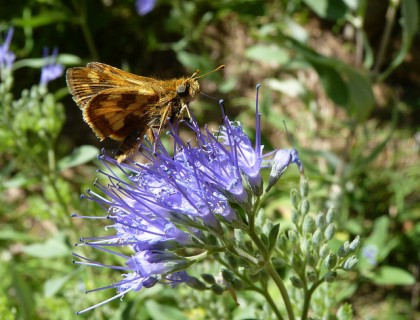
Mahonia. This genus has several members whose flowers will delight your winged friends. Mahonia aquifolium is a familiar shrub known as Oregon Grape Holly. It is evergreen, easy to grow and produces edible (but not tasty) berries from the yellow flowers that bees appreciate. 4-6’ Ht. x 4-6’ Wd.
Prunus bessyi, Sand Cherry 4-6’ Ht. x 4-6’ Wd.
Philadelphus lewisii, Cheyenne Mock Orange 5-7’ Ht. x 4-6’ Wd.
Rhus aromatica ssp. Trilobata, Three leaf sumac 3-6’ Ht. x 3-6’ Wd.
Rosa woodsii, Wood’s Rose 3-6’ Ht. x 3-6’ Wd.
Trees for Butterflies and Bees
Tilia cordata, Little Leaf Linden. Linden trees perfume the air in springtime and offer up small yellow flowers (see photo below) for pollinators. I’ve heard that in Eastern Europe, a type of beer is flavored with the linden flowers. 30-50’ Ht. x 25-35’ Wd. (depends on cultivar).
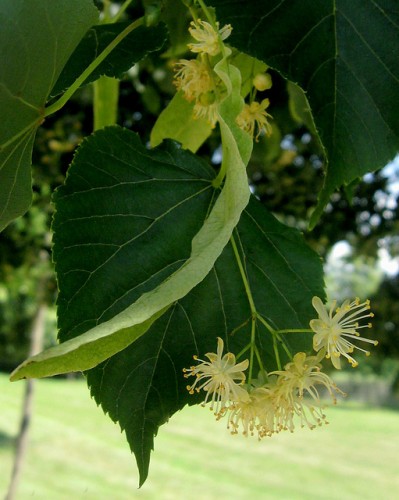
Apple / Crabapples. The Malus genus offers many species and cultivars that are attractive to bees. In fact, if there were no bees, you probably would not get any fruit from your apple trees. Ht. and Wd. varies depending on cultivar.
Prunus armeniaca ‘Moongold’, Moongold Apricot. 15-25’ Ht. x 15-25’ Wd.
Prunus nigra ‘Princess Kay’, Princess Kay Plum 15-20’ Ht. x 10-15’ Wd.
Catalpa speciosa, Western Catalpa 40-60’ Ht. x 30-50’ Wd.
Cercis Canadensis, Eastern Redbud 20-30’ Ht. x 20-30’ Wd.
Crataegus ambigua, Russian Hawthorne 15-25’ Ht. x 20’ Wd.
This is the official blog of Outdoor Design Group, Colorado Landscape Architects. For more information about our business and our services, click here.
Related Posts:
by Todd Rutherford
When discussing Yucca plants with other people, I’m usually presented with two responses: the majority who detest them, and the few people who love them. If you are of the former, I hope I can convince you to move towards the latter group. Or at least I hope to persuade you to begin to reconsider the so-called “yucky Yuccas.”
There is one type of Yucca in particular that turned me into a Yucca fan. This would be Yucca filamentosa. This Yucca has all the things that make many Yuccas great for Colorado gardens: low water requirement, dramatic flowers that are pollinated at night by moths, and evergreen winter interest.
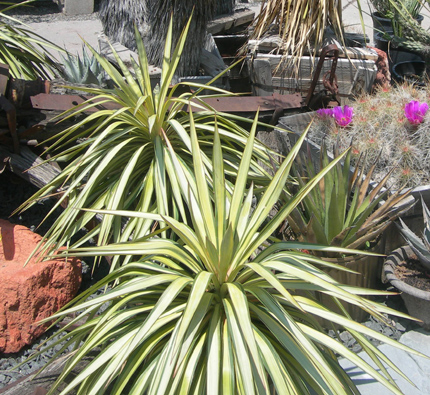
What Y. filamentosa has that other yuccas that can grow in our hardiness zone don’t have is softer leaves that can fold over towards the end, despite having sharp tips. This makes it a possibly better choice for gardeners who might be concerned about the stiff, sword like nature of some yuccas such as Y. glauca (which still make great landscape plants!). In addition these Yuccas can take some filtered shade, whereas most Yuccas prefer only full sun. Keep in mind that Yuccas, like many low-water garden plants prefer good drainage to avoid root rot. In addition to Adam’s Needle, there are a few other varieties of Y. filamentosa that offer variegated leaf color, such as Bright Edge Yucca and Color Guard Yucca.
Similar to Y. filamentosa is Y. flaccida. Y. flaccida hails from the Appalachian Mountains. Just like Y. filamentosa, Y. flaccida is more accustomed to your average garden soils and watering regimen. If you want to add a Yucca to an area that already contains other perennials that are not extremely xeric, you should consider Y. filamentosa and Y. flaccida. But while these two species can desire more water than the other yucca species, they are still low water plants that need well-drained soil to keep them happy.
If it is architectural drama you seek for your garden, consider planting Yucca thompsoniana. Thompson’s Yucca is native to New Mexico, Texas, and northern Mexico. Under the right conditions, it may reach up to 10 feet tall. Thompson’s Yucca stems can even sometimes branch off, giving a similar look to the famous Joshua Tree Yuccas (Yucca brevifolia). Flowers are borne on 3 to 5 foot spikes, further increasing the drama of these beauties. For inspiration I recommend you visit the Thompson Yuccas at the Denver Botanic Gardens.
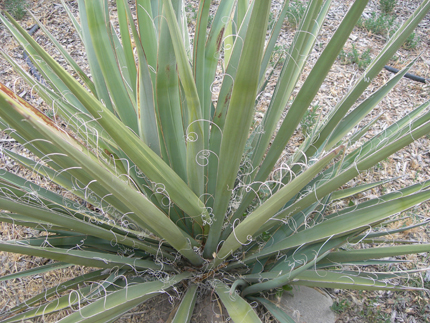
Another captivating form of Yucca is Y. baccata, commonly called Banana Yucca. It was a source of food for Native Americans of the Southwest. The long, stiff bluish-green leaves often curl back toward the base, and sport course curled fibers along the edges. Those curled fibers look striking in afternoon backlight. Banana Yucca can reach a height of 4 feet and width of 5 feet, so give it a good, dry space to thrive.
For native plant purists on Colorado’s Front Range, the Soapweed Yucca (Y. glauca) is a good choice. It is distributed widely across the high plains and foothills of Colorado, and is found from Canada to Texas. It is the most cold-hardy Yucca species available. As I mentioned previously, this Yucca has stiff leaves with sharp tips. Y. glauca grows 2-4’ tall and 2-4’ wide, and requires very little water.
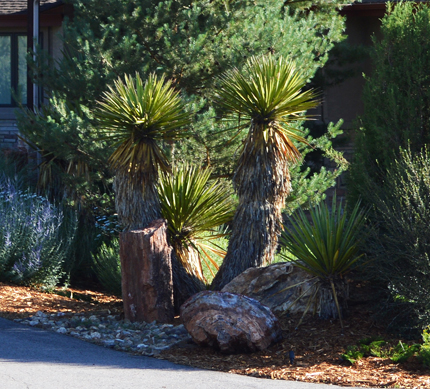
Yucca faxoniana
If you have been avoiding the so-called Yucky Yuccas, please reconsider your position and give one of these xeriscape essentials a spot in your low-water landscape.
This is the official blog of Outdoor Design Group, Colorado Landscape Architects. For more information about our business and our services, click here.
Related Posts:
by Todd Rutherford
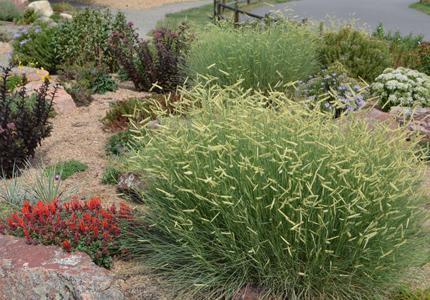
Teasing you with its profusion of blonde colored, eye-lash shaped seed heads, this ornamental selection of the western native Blue Grama grass will wow you. Introduced by David Salman of High Country Gardens, Bouteloua gracilis ‘Blonde Ambition’ was a 2011 Plant Select winner.
Resplendent on a sunny fall or winter day, the gold leaves and seed heads look great against small evergreens, a dark wall or landscape boulders. Even winter snows can’t stop this grass from providing captivating winter interest, as it seems to stand up through heavy snows better than other ornamental grasses. And in summer, the light blue-green foliage can’t be stopped by heat or drought. ‘BlondeAmbition’ mixes well with many xeriscape staples such as Autumn Joy Sedum or English Lavender, and also looks great in masses as well.
Would you like to attract some eyeballs to your landscape by reserving a spot in your garden for this blonde bombshell?
Scientific Name: Bouteloua gracilis ‘Blonde Ambition’
Plant Type: Perennial
Mature Height: 12”-36”
Mature Spread: 12”-24”
Cold Hardiness Zone: 4 – 9.
Water Requirement: Very low. Grows in a wide range of soil conditions.
Exposure: Full Sun.
Flower Color & Bloom Time: Chartreuse to Gold. Summer.
Winter Interest: Gold leaves and curly seed heads.
Best Features: Profusion of gold colored eye-lash shaped seed heads. Great color and shape throughout fall into winter.
Disadvantages: unknown
Availability and Sizes: This plant seems to be regularly available.
Maintenance Tip: Shear back in late winter / early spring to give room for new growth.
Wildlife Value: unknown
This is the official blog of Outdoor Design Group, Colorado Landscape Architects. For more information about our business and our services, click here.
Related Posts:
by Todd Rutherford
One of the joys of gardening in Colorado is discovering beautiful North American native plants that thrive in our challenging growing conditions. A group of perennial flowers that are great for a low-water garden in our region are the Penstemons, also known as the Beardtongues.
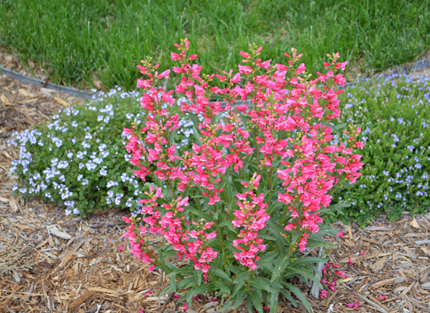
Coming from the Snapdragon family of flowering plants, penstemons provide a multitude of tubular flowers on their inflorescence that rise up above their various leaves. There are over 200 species of Penstemons. Their habits range from low growing ground cover types to taller ones that work in mixed border plantings or as showy specimen plants.
Although penstemons are usually short lived, around 3-4 years, many are easy to propagate from seed. Usually the life of the plants can be extended if you don’t overwater and if you dead-head the flowers after blooming.
Two species that I’ve grown from seed and that are quite striking in the garden are Penstemon barbatus, aka Scarlet Bugler Beardtongue, and Penstemon strictus, aka Rocky Mountain Penstemon. Penstemon barbatus has smaller gorgeous bright orange-red flowers, and Penstemon strictus has larger blue-purple colored flowers.
Definitely consider adding one of the beautiful and hardy penstemons to your water smart garden.
This is the official blog of Outdoor Design Group, Colorado Landscape Architects. For more information about our business and our services, click here.
Related Posts:













